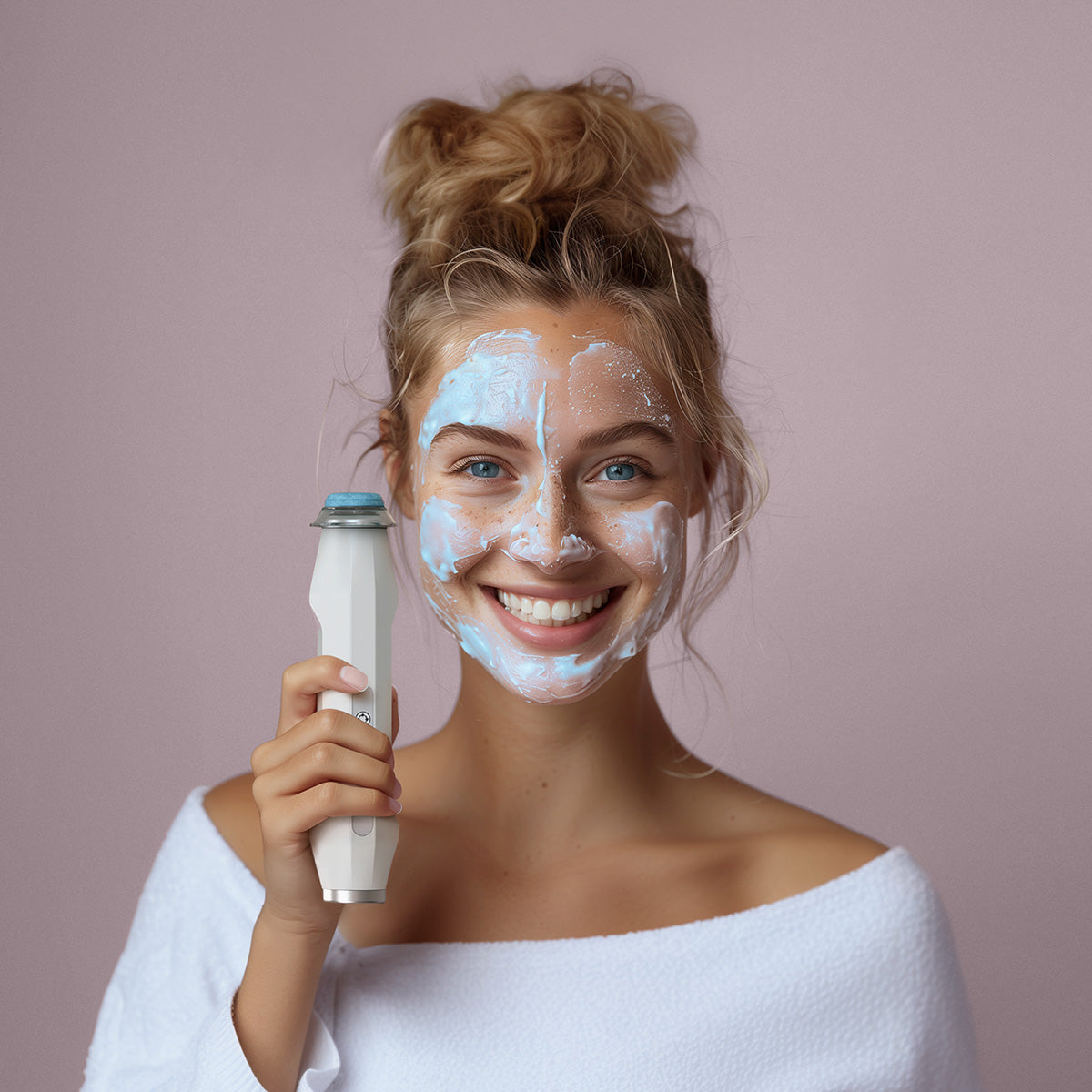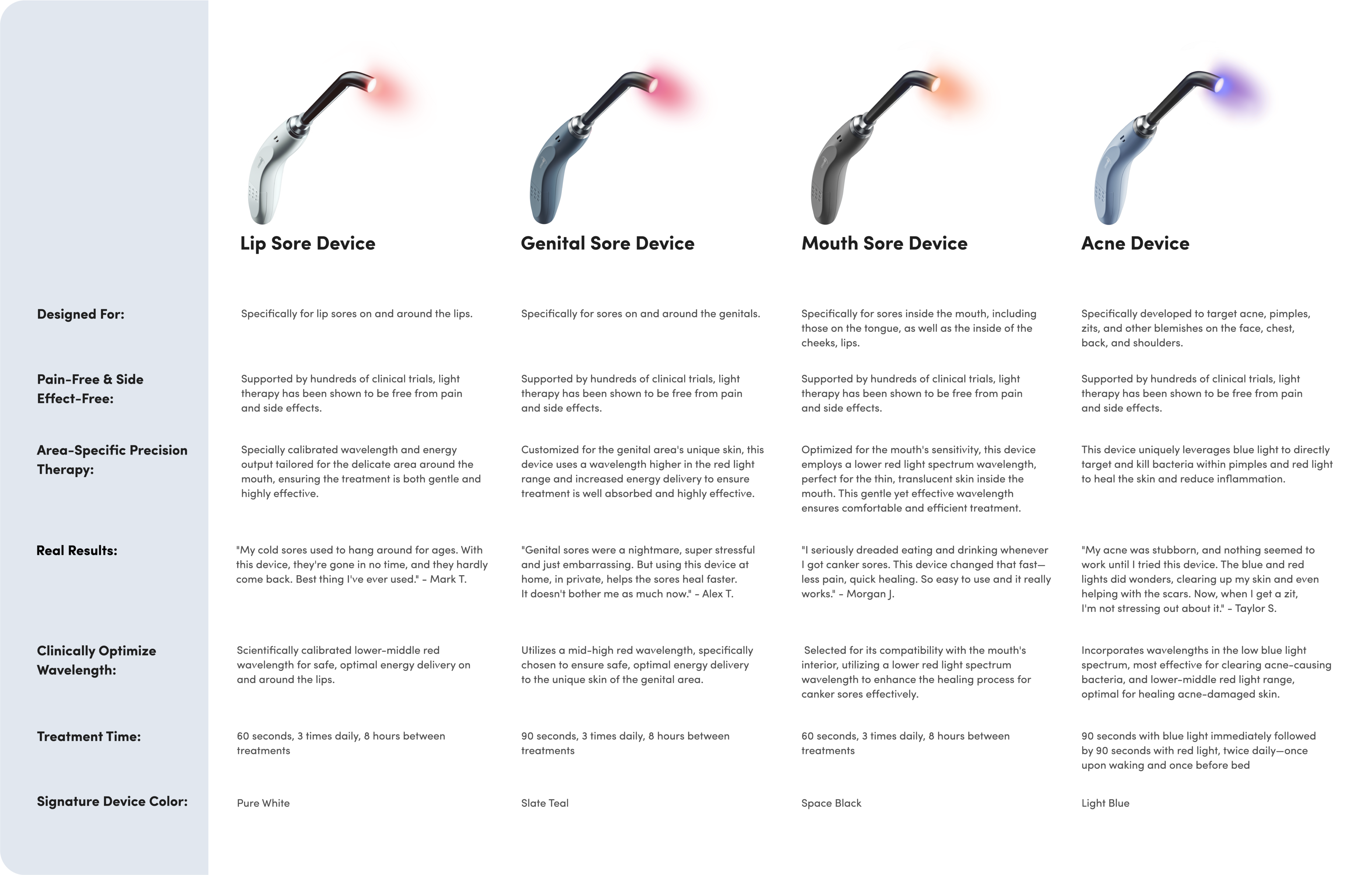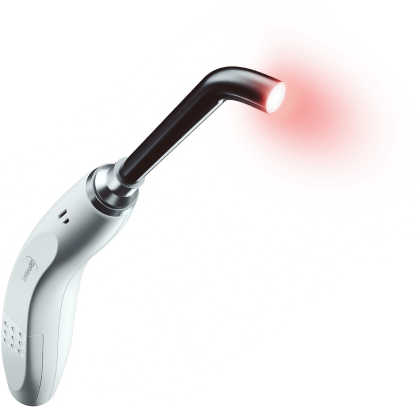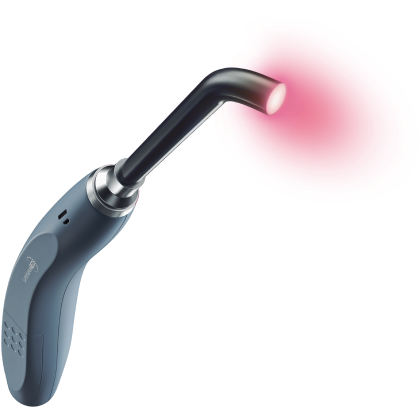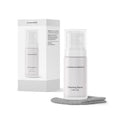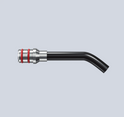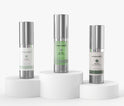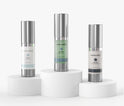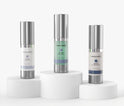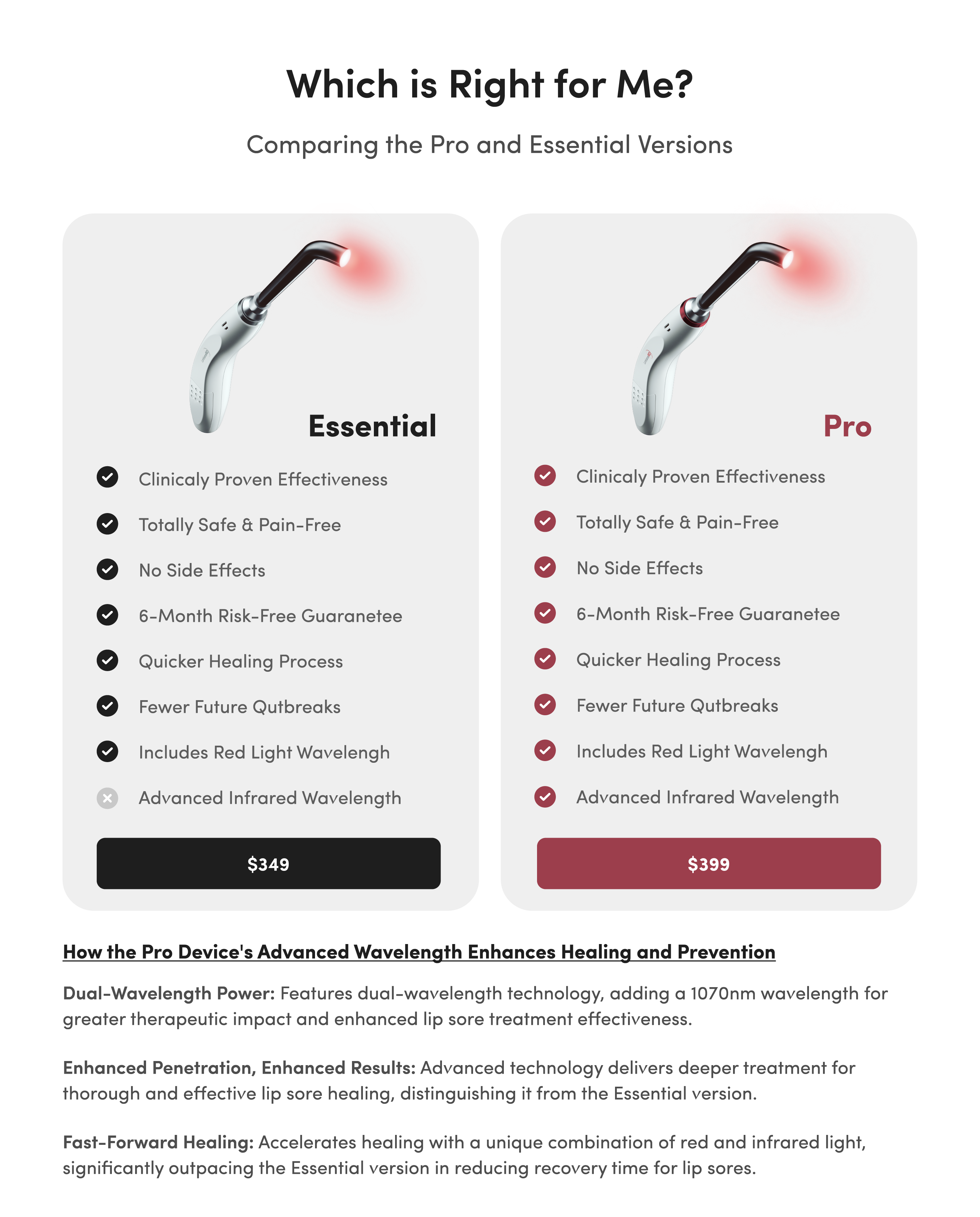The Luminance RED vs Abreva: Decide What’s Right for You

Are you a long-time sufferer of recurrent cold sores? If so, you’d likely do anything to speed up the healing of your cold sore ulcers and increase the time between outbreaks.
Two of the most effective means to achieve those ends are the over-the-counter cream Abreva and the Luminance RED. Though very different in design and functionality, both treatments can fight cold sores caused by the herpes simplex virus (HSV).
So, when comparing the Luminance RED vs. Abreva, how do you decide which is the right choice for you?
The Luminance RED vs. Abreva: What Is Abreva?
Before we compare the Luminance RED vs. Abreva, let’s define what exactly Abreva is.
Abreva is an over-the-counter (OTC) cream used to treat cold sores. It contains the only non-prescription ingredient approved by the FDA to accelerate the cold sore healing process. (We’ll explore this active ingredient later).
According to clinical research, Abreva can reduce healing time to as little as 2.5 days, or 4.1 days on average.
For best results, apply Abreva directly to your cold sore at the first sign of an outbreak (i.e., the tingling sensation on the spot where the ulcer is about to form). Repeat this application up to five times per day to keep the area consistently covered.
Abreva’s Active Ingredient
The active ingredient in Abreva is docosanol, a saturated fatty alcohol.
1-Docosanol, or behenyl alcohol, was approved in the United States in the year 2000 as an antiviral medication to treat cold sores. According to clinical trials, the most common side effects are skin itching and redness where the medication is applied. You may experience more serious side effects if you have an allergic reaction to docosanol.
Docosanol prohibits bonding of the cells in your body to the herpes simplex virus, the virus that causes cold sores. Without this bonding, the herpes virus is unable to replicate.
According to a 2001 study, docosanol can reduce the healing time of herpes sores at a concentration of 10%. The concentration of docosanol found in Abreva is also 10%, making it a clinically supported way to reduce the life of your cold sore.
The inactive ingredients in Abreva include:
- Benzyl alcohol
- Light mineral oil
- Propylene glycol
- Purified water
- Sucrose distearate
- Sucrose stearate.
If you are allergic to docosanol or any of these inactive ingredients, do not use Abreva. Opt for other over-the-counter treatments, such as Orajel, Compeed Cold Sore Patches, or the Luminance RED.
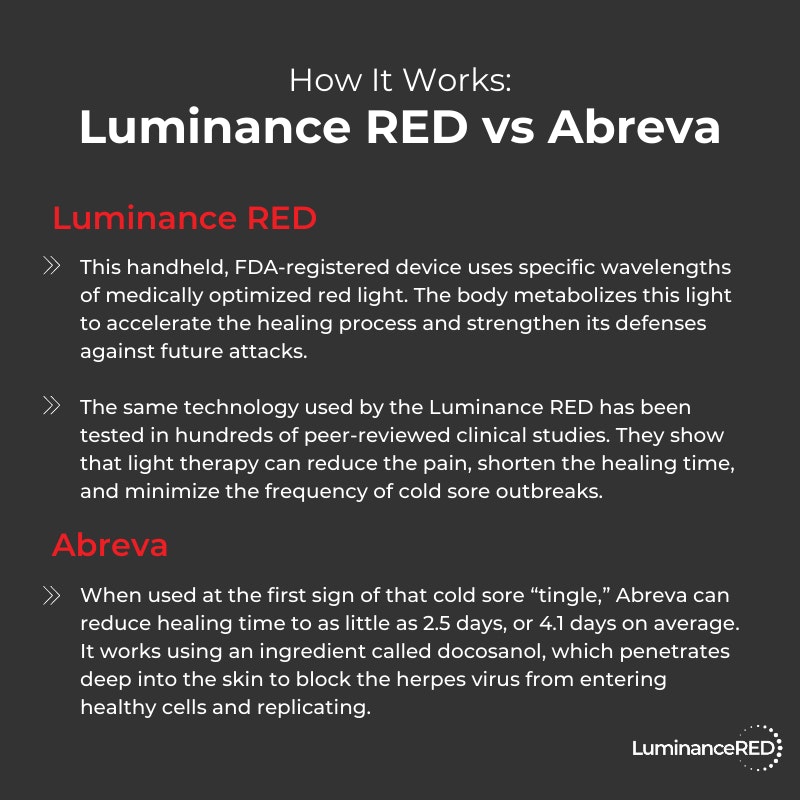
The Luminance RED vs. Abreva: What Is the Luminance RED?
Again, before we compare the Luminance RED vs. Abreva, we need to explore the Luminance RED’s functions and strengths.
The Luminance RED is a handheld, FDA-registered device designed to manage cold sores using phototherapy. During treatment sessions, the Luminance RED casts specific wavelengths of medically optimized red light over the affected area. The body’s cells metabolize this light to accelerate the healing process and strengthen its defenses against further viral attacks.
The Luminance RED is designed for use in the privacy of your own home. For best results, hold the light one centimeter away from the treatment area for 60 seconds up to three times per day.
Clinical Research
When considering light therapy vs. Abreva, remember that clinical studies have repeatedly demonstrated the power of phototherapy to prevent herpes outbreaks and alleviate active cold sores.
In a study of participants with at least one oral herpes attack per month for more than six months, patients who received phototherapy treatment averaged 37.5 weeks before their next cold sore episode, compared to only three weeks for patients who received a placebo.
Another study found that patients who received treatment with light therapy had a 49% reduction in healing time compared to those who received no treatment. The treatment group healed after an average of 2.2 days, while the untreated group healed after an average of 4.3 days.
The Luminance RED was designed to use the wavelength and irradiance specifications studied in these trials to maximize efficiency in treating and preventing cold sore outbreaks. The difference is that the Luminance RED device makes this therapy available in your own home versus in a clinic or doctor’s office.

The Luminance RED vs. Abreva: The Key Differences
It’s difficult to compare the Luminance RED vs. Abreva, as both treatment options offer individual benefits.
Abreva is a cream, while the Luminance RED is a red light laser. It’s easy to quickly apply Abreva before work or in between activities, but it can also be messy and smear off your skin throughout the day.
By contrast, the Luminance RED is compact and can be used anywhere, any time, without any complications. Just hold the device to your cold sore and let the red light penetrate deep into your skin.
The Luminance RED offers more flexibility and range of use than Abreva, which is “indicated only for the treatment of cold sores,” meaning it can’t fight other kinds of ulcers. Light therapy, on the other hand, isn’t limited to fighting cold sores; it can address many different conditions, such as canker sores and genital herpes.
Perhaps the most significant difference between Abreva and the Luminance RED is each product’s ability to treat and prevent outbreaks. Abreva can treat cold sores as they emerge, but the Luminance RED device is designed to both treat existing cold sores and prevent future outbreaks.
Side Effects
As we continue to compare the Luminance RED vs. Abreva, let’s explore each product’s safety profiles.
Abreva is approved for use in adults and children over the age of 12. It is not an appropriate treatment for a younger child and could potentially cause some adverse side effects in adults as well, including:
- Headache
- Itchiness
- Rash
- Redness
- Swelling
If these side effects go away within a short time, then it’s likely safe to continue using Abreva. However, if the side effects continue or start to get worse, wash off the product right away and contact your doctor.
The light therapy technology used by Luminance RED is not harmful when applied to your skin. When at-home treatment devices are used properly, there are essentially no side effects or risks to consider. However, misuse of your device could potentially cause cell or tissue damage.
The Luminance RED device is safe for all skin types and may be used on children and adults, though you should still consult your doctor before using it on a child.
Additional Pros and Cons
Let’s consider a few other pros and cons of the Luminance RED vs. Abreva.
While both treatment options are relatively affordable, one tube of Abreva is much less expensive than the Luminance RED. However, the Luminance RED is a one-time purchase, while recurrent cold sore sufferers will have to buy countless tubes of Abreva for years to come.
You may get some satisfaction out of the immediate feeling of relief provided by applying a topical gel to your cold sore, but while Abreva is effective at reducing healing time, light therapy has been clinically demonstrated to promote faster healing times, reduced pain, and fewer outbreaks in the future.
Finally, when comparing light therapy vs. Abreva, we can’t stress enough that even though Abreva is helpful in the midst of an uncomfortable outbreak, it won’t prevent cold sores from appearing in the future.

Light Therapy vs. Abreva: Which Is Right for You?
When it comes to light therapy vs. Abreva, both have their place in the fight against recurrent cold sores.
Abreva’s topical cream is meant to address active outbreaks to reduce symptoms and healing time. The Luminance RED’s phototherapy technology can also achieve these results, as well as prevent future outbreaks.
Instead of comparing light therapy vs. Abreva, consider using the Luminance RED in combination with Abreva.
You may find that one or the other best fits your needs, or you may use them together. As of this writing, no published research definitively proves they work well together, but no research indicates any reason they wouldn’t, either.
Try using Abreva and the Luminance RED device in conjunction to encourage the best results possible.



